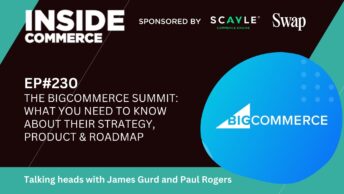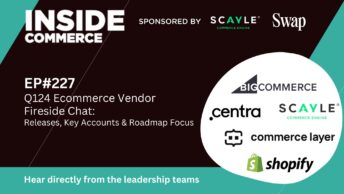In this episode James and Paul discuss valid use cases for when investment in a specialist CMS is required because native page builders can’t satisfy the business needs.
Listen on your favourite player
Watch the video
Content features quite highly in most ecommerce platform RFPs, especially with brands looking to focus on customer experience and not just commerce capability. Vendors talk about their page builders whereas businesses are expecting a CMS (content management system). In this ecommerce podcast we look at valid use cases for when investment in a specialist CMS is required because native page builders can’t satisfy the business needs. Please note by native page builder, we mean the inbuilt page builders on market leading ecommerce platforms such as Salesforce Commerce Cloud, Adobe Commerce, Shopify Plus, Big Commerce and Shopware.
Tl;dr – what we cover:
- When does a Page Builder suffice for an ecommerce business?
- What can’t a page builder do that a specialist CMS can?
- How do you meaningfully evaluate a CMS?
Key discussion points
- When is a page builder good enough?
- Starting point is don’t spend on licensing for a 3rd party CMS if you don’t need to i.e. might be able to use the Page Builder for phase 1 and then evolve to CMS in future
- A specialist CMS can cost upwards of £20k p.a. (£100k + for large sites with thousands of content pages) licensing + integration fees
- Many teams just want a strong visual, drag & drop editor where they can rapidly edit / create pages without needing a developer: modern page builders in ecom platforms do this e.g. Shopify Sections Everywhere, Shopware Customer Experiences, Big Commerce page builder
- Page builders can:
- Build custom page templates and content components (layouts) aligned with brand designs
- Deliver mobile responsive designs with templates and components that adhere to required break points
- Build content component logic to function as required, not just look how it needs to e.g. an image + text layout where you can add a heading, body copy and CTA button, edit the text, change image, switch image from left to right etc.
- Restrict access via user permissions and control who can upload, create, edit, publish
- Schedule publishing of a webpage of new content layout in the local timezone of the storefront
- Live Preview of content in the browser
- Insert HTML into page templates
- Insert content into commerce pages e.g. above the product grid on a PLP, PDP, basket (such as USP block)
- Insert hero content into the PLP product grid – jewellery and fashion brands do this well e.g. Tiffany, Gucci
- Set core SEO properties for content pages including the homepage
- Manage the main menu hierarchy, links and visual content
- Set image import parameters to ensure optimised imagery with SEO friendly meta data inc. image title, description & URL
- Show the edit history to enable auditing of content changes
- Make content visible/not visible to specific stores/customers
- Integrate with rule builders to control when custom content is shown and where e.g. show banner to VIP customers in basket promoting free next day shipping
- Embed content hosted externally e.g. video on You Tube and Vimeo
- What can an enterprise CMS do that the page builder can’t?
- Automated publishing from staging to production (but is this really important – can do live previews in Page Builders and schedule the publish time/date)
- Replication from one storefront to another, beneficial for multi-storefront businesses where not all storefronts have locally customised content
- Create a single asset and publish to multiple content locations in one
- Distributed content workflows for global teams to align with enterprise content management processes & permissions
- Richer layouts without having to create custom code e.g. image hotspots
- Content personalisation, enabling targeting of different content assets based on user ID/group
- User journey personalisation: tailor what customers see based on their profile e.g. different sign up process for trade, change form layouts
- Strong digital asset management e.g. handling image presets for marketing channels
- Preview content for a specific future date, useful when simultaneously planning multiple campaigns and launches that are in different stages of development
- How should you evaluate CMS providers?
- Integration with your ecommerce platform: how is this done, how many live Client sites
- Template and component creation: how much dev work required, how easy is it to self-serve from an existing library?
- Logic control: can the logic of components be changed e.g. you have a carousel that autoplays but want it static with scroll bar, a content & image block where you toggle a CTA on/off
- Create once publish to multiple locations: how do you easily publish the same content component/layout into more than one page without having to re-create it for every page?
- Performance: how performant are the live sites, check metrics like CWV
- Staging and production: what’s the deployment process & effort, how much is automated
- Analytics: what reporting is standard, how can you assess the impact and use of content?
- What’s the ROI for investing in a CMS?
- Reducing inefficient process: calculate time saved
- Reduced dev hours
- Offset cost of dev to setup page builder & maintain vs. annual license fee – cost neutral?
- SEO benefit of being able to create deeper editorial content hubs, traffic and revenue boost
Want to suggest a topic or guest for a future episode? Contact us via the website or on Twitter.





